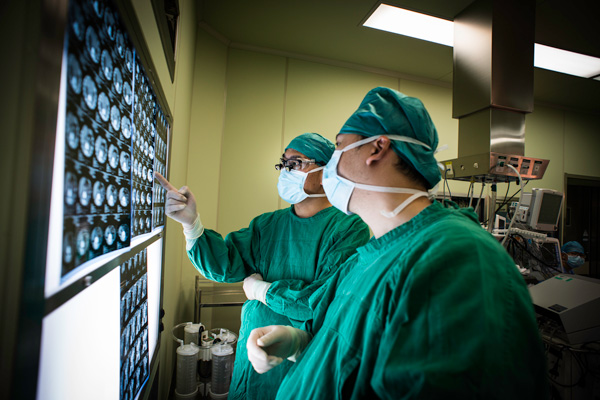Nation's medical imaging industry enters new era
 |
|
Doctors examine a patient's CT images at a hospital in Beijing. PROVIDED TO CHINA DAILY |
Medical imaging changed the face of medical science and now it is big business.
In China, the market is estimated to grow between 600 billion yuan ($87 billion) and 800 billion yuan by 2020 from 400 billion yuan in 2015.
Diagnosing major health problems has been revolutionized by imaging technology, which creates a visual representation of the interior of a body for clinical analysis and medical intervention.
But the process is still suffering key problems, according to a report by Firestone Inventing, a consulting company specializing in the medical industry.
"China's medical imaging sector is growing at a rate of 30 percent annually, but the demand for superior medical treatment can not be met at present," said Ni Meng, founder and chief executive officer of Wingspan Technology Inc, a medical imaging company.
Long waiting times, poor diagnosis rates and data managing problems plague the industry here.
But the government is making inroads into tackling the challenges with policies that will open up new opportunities for the medical imaging sector.
One of the priorities will be to manufacture high-tech equipment in China by domestic companies as patients are demanding state-of-the-art treatment techniques.
"Home-made medical imaging equipment is going to be a future direction," said Zhang Jiang, general manager of Ping An Ventures, a venture capital firm specializing in various sectors including healthcare.
"Medical imaging is a core technology of diagnosis, especially for cases such as cancer screening. In fact, more foreign companies are investing in Chinese firms that make domestic medical imaging equipment."
Still, problems persist. The Firestone Inventing report showed there were just 402 Chinese companies manufacturing the equipment, accounting for only 10 percent of the market.
In addition, the healthcare sector lacks imaging technology in ophthalmology and dentistry.
"The major breakthrough for China is to upgrade it by producing high-end products instead of mid-to low-end devices," said Yang Hongfei, chief executive officer of Firestone Inventing in Hangzhou, Zhejiang province.
During the past five years, there has been a rapid growth of Chinese patents covering the sector. The country now ranks third in terms of the number of medical imaging patents filed behind Japan and the United States.
"Big data and artificial intelligence are going to lead the development of medical imaging sector," the Firestone Inventing report highlighted. "Artificial intelligence provides medical imaging with intelligent analysis applications. As for big data, it offers detailed analysis into patients' health."
Last year, the State Council issued a guideline on promoting the application of medical big data in clinical diagnosis, and medical research and development.
Big data are a term used for crunching vast amounts of statistics to show trends and flaws in market information.
"From human body X-rays to telemedicine and medical imaging, we are on the brink of entering a new age of artificial intelligence," said Mou Xiaoyong, president of United Imaging Healthcare.




















